FastTrack Training. "Network Basics". "The Basics of Telephony." Part 3. Eddie Martin. December 2012
About a year ago, I noticed an interesting and fascinating series of lectures by Eddie Martin, which, thanks to its history and real-life examples, as well as its tremendous learning experience, is amazingly comprehensible and allows you to gain an understanding of quite complex technologies.

We continue the cycle of 27 articles based on his lectures:
')
01/02: “Understanding the OSI Model” Part 1 / Part 2
03: "Understanding the Cisco Architecture"
04/05: “The Basics of Switching or Switches” Part 1 / Part 2
06: "Switches from Cisco"
07: "Area of use of network switches, the value of Cisco switches"
08/09: "Basics of a Wireless LAN" Part 1 / Part 2
10: "Products in the field of wireless LAN"
11: The Value of Cisco Wireless LANs
12: Routing Basics
13: "The structure of routers, routing platforms from Cisco"
14: The Value of Cisco Routers
15/16: “The Basics of Data Centers” Part 1 / Part 2
17: "Equipment for data centers"
18: "The Value of Cisco in Data Centers"
19/20/21: "The Basics of Telephony" Part 1 / Part 2 / Part 3
22: "Cisco Collaboration Software"
23: The Value of Collaboration Products from Cisco
24: "The Basics of Security"
25: "Cisco Security Software"
26: "The Value of Cisco Security Products"
27: "Understanding Cisco Architectural Games (Review)"
And here is the twenty-first of them.
The communications manager of the SM is central to everything we do. And plays an important role for voice.
What is Jabber? I was waiting for this question from you! I wait for him every time I start talking about telephony. Jabber was originally the name of a company that created its own, non-standard protocol that was simpler than the traditional protocol used in SIP. The traditional protocol was not effective enough in this case.
Jabber created a separate protocol that was a more adaptable and thinner client that was easily used in networks. Cisco acquired Jabber in 2008. Their Jabber protocol has become the standard XMPP protocol that provided instant messaging and reported the user's presence on the network, and it is still used as the main protocol for this purpose.
Jabber is now a serious software client that Cisco uses on your devices. If you have a computer phone program, it uses Jabber for Windows, if you have a MacBook, it uses Jabber for Mac OS, if you have an iPhone, then it uses Jabber for iPhone. Jabber for iPad and Jabber for Android are available. It is a universal client for all mobile and stationary devices with any operating system. In fact, “Jabber” is a whole line of products that allows the exchange of voice messages. I use it on my MacBook and I can receive a voice mail message, and with the help of another client I can receive a video to it, even after a month. I think that the next version of Jabber will acquire this feature and will also be able to work with email video messages.
We need to download Jabber, if it is required by the CM communications manager, otherwise we do not need it.
Jabber also works with video, but in real time, like Skype, when I, for example, talk to my wife via MacBook. We can say that this is an analogue of Cisco's Cisco. Often, people incorrectly call Skype client, it is wrong. You cannot take Skype and put it inside our telephone network. Does a client need to know your IP address? Not. Simply log in to the server.

Suppose I take my iPhone, it is located on the right on our picture, I log in to the system and dial a person with an IP phone on the left side of the picture. My client interacts with the CM, his client also interacts with the CM, and the communications manager connects us. If I want to talk to another subscriber located outside our corporate network, the SM determines this, creates a secure “tunnel”, that is, a secure channel, and I call this subscriber as if he belonged to our network.

So, Jabber is our client. I note that there are no perfect clients for either Mac or Android.
What is WebEx? Where is he in this picture? He is in the cloud! He needs a cloud service company. This is a serious product, thanks to which we can create conferences and share our desktop, it also reports the presence of the user. It provides video broadcast solutions and allows you to record this event. In fact, we have as far as WebEx centers. This is the Meeting Center conference center that allows you to organize video bridges. We can share documents. This is followed by the Training Center. What is the difference between these centers?
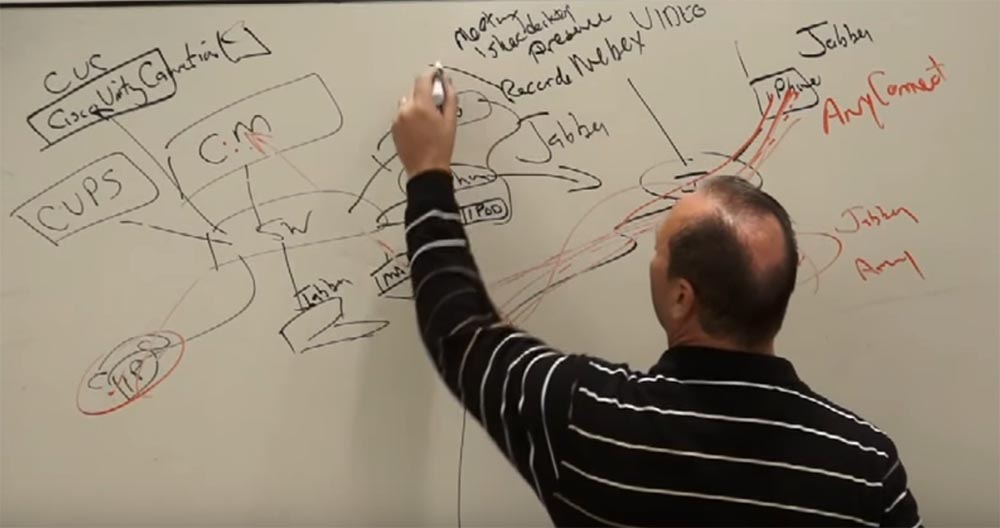
In the training center, I can do whatever I want to organize a conference. Here I can create small groups of people, test their work, I can quickly select people into small groups and then quickly return them to the general group, I can instantly run conferences. This is really a very powerful tool.
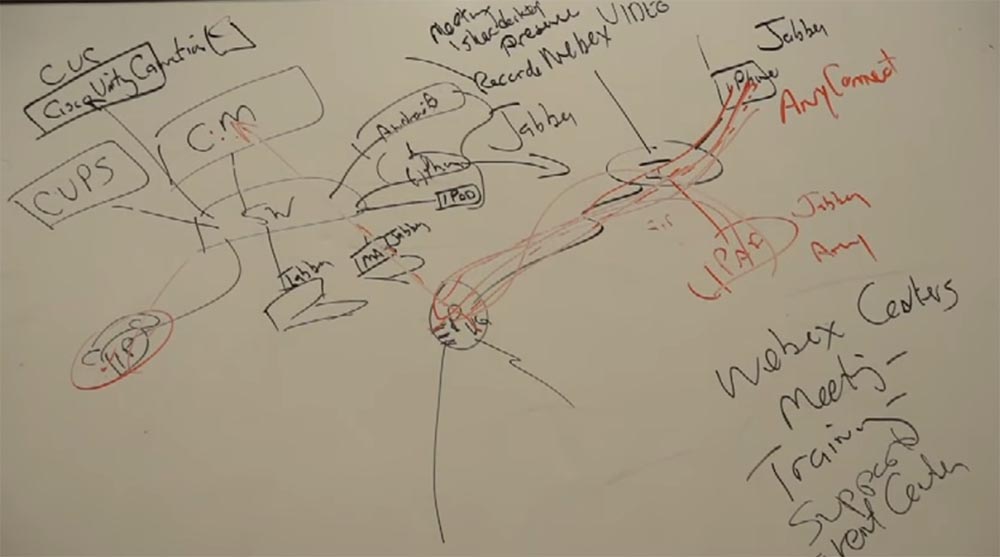
Next we have a support center support center. Here we provide technical assistance, monitor your laptop and provide remote assistance to your desktop, if you need it.
Even in our WebEx there is an Event Center event center. Suppose I have a new product that I want to introduce everywhere, and I wish that 5,000 people would become familiar with it. I want them to purchase my equipment. Do I need to fly to all these people and offer it to them personally? No, I just join the center of events and create my own market there. I see my buyers there and I can even check whether they are satisfied with the purchase of the reviews they leave. This is a great deal for organizing trade.
The training center also helps to collect useful statistics, such as how many emails you send.
Jabber is a federated client, it is designed for federated networks where everyone can log in and create their own node. Users of this client can exchange messages using different servers.
The WebEx cloud service is free to interact with the Salesforce cloud service. We also provide our clients with a set of Jabber SDK development tools so that they can integrate the client into their SAP business automation systems.
The proposed architecture has unlimited possibilities. We can add more and more applications to it. We have a virtual server application that is compatible with any other applications.
I will note that the Jabber user can be placed outside of our federated network and our firewall, and it will still work with our corporate client. I can use this client on different servers.
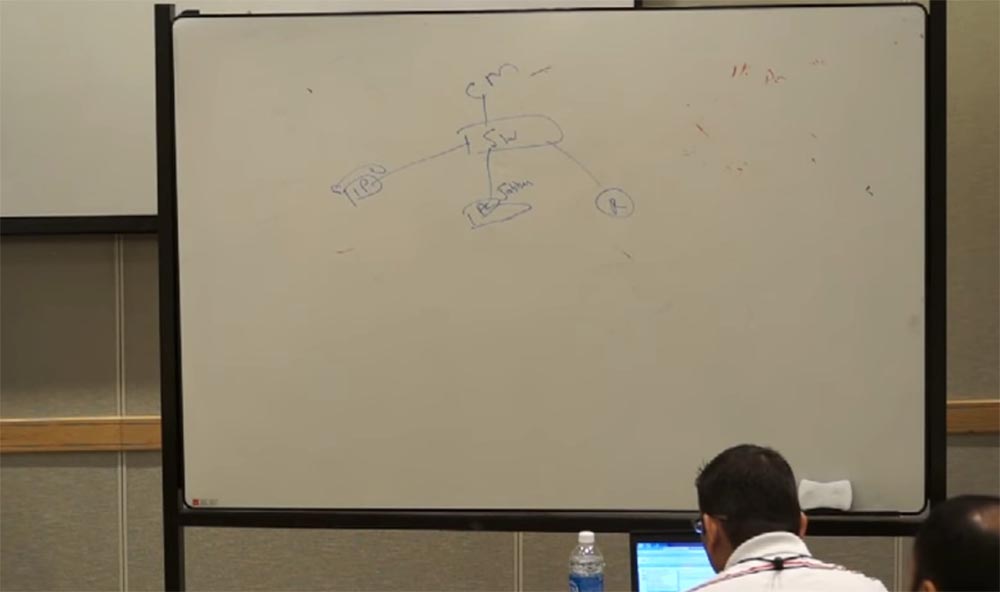
We will now return to our old scheme. I will draw a communications manager SM, a switch, a router, a PC with Jabber, an IP phone.
Once Cisco acquired the Norwegian company Tandberg, which developed and manufactured equipment for video communications. Cisco has long been engaged in the development of video transmission tools. If you remember, in the late 1990s, Cisco created the Avid architecture for voice, video, and integrated data. I have seen a lot of sold systems for voice, but I have not seen sold systems for video transmission. This video equipment scares me a little, I am a specialist in networks that mainly use voice. Tandberg has made great strides in selling video systems. This has become very important and today everyone needs systems for video transmission.
Consider again how this was integrated into our solutions. CM establishes a connection and monitors calls. But suppose that you have the largest video device for conferences on three screens - the TX 9000 or CTS 3000. This is an Immersive device that creates a 3D volume image to cover the user. I will depict it in the left upper part of the picture, and to the right and above the switch I will place the video input device, without which our three screens are useless. This is a codec and image decoder. It is connected via a switch to the CM communication manager.
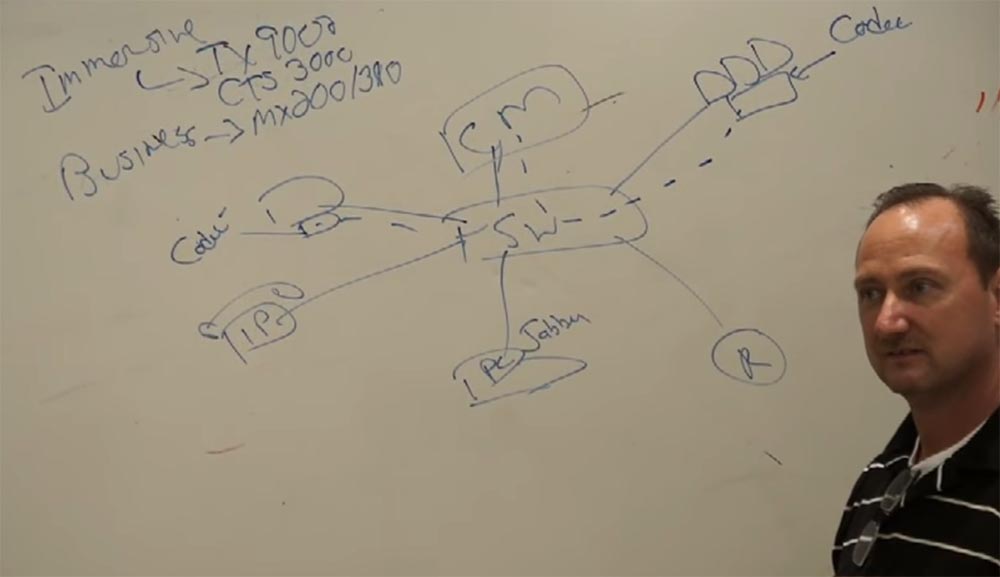
We know that CM manages the voice stream. But he also manages the video stream. I’ll add business video system MX 200/300 to the left. It has one screen. To process such an image, you need your video codec, I will draw it on the upper left of the switch. He is also associated with SM.
Let's add another personal video device of the EX 60/90 series with a screen of 21 or 24 inches. What is located outside of it? A codec that is also associated with a communications manager.
Thus, we can connect all these video devices to the SM just as we connected voice devices. However, the process of transmitting video is somewhat different from the process of voice transmission. How do we arrange a video conference? We can report it to participants via Outlook. Suppose I want to arrange a meeting with you three, but first I want to discuss important things with one of you.

I create an agenda, or a visit schedule. Suppose I want to talk to the first person in a room with three screens. I create a meeting, the participants of which will be me, he and the room with the screens.
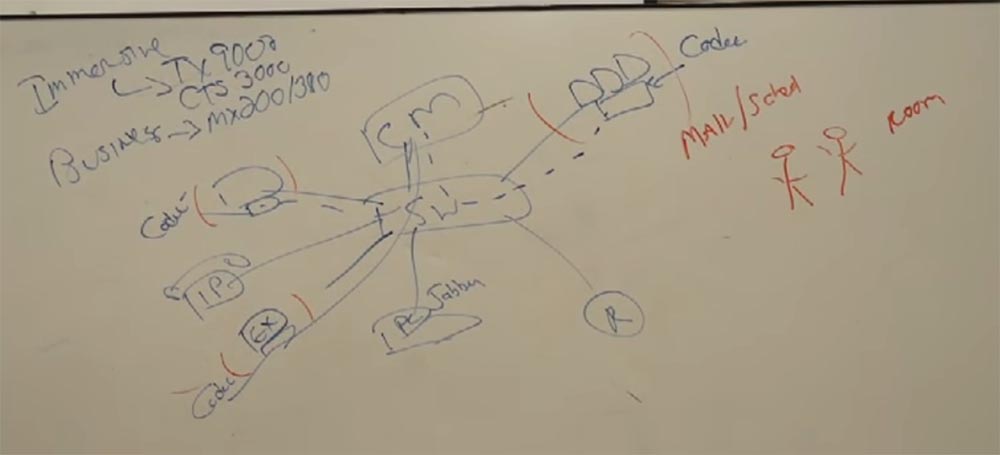
I have a schedule like the one who made the appointment, you have it as an invitee, and what is the schedule for the room with screens? Tandberg's app called TMS is a presentation management suite. It controls the room, or rather, the video device placed in it. This application is a schedule or a schedule of equipment operation.
When I send a letter, it goes to the email inbox, and TMS replies that it received the letter and made a schedule for all your video equipment and a schedule for the rooms where it is located. In the room with our three screens there is a tablet, and if you go there at the appointed time, you can see the inscription on its screen: "Your conference is here." She was placed there by the communications manager SM. You press a button on the tablet and thereby send a CM signal that the conference has begun.
After receiving the signal, the CM addresses the TMS with a request for what is needed for the meeting. TMS replies that it is necessary to connect a room with three screens and a room where there is an EX screen. This is how the necessary connection between the participants of the meeting is established.
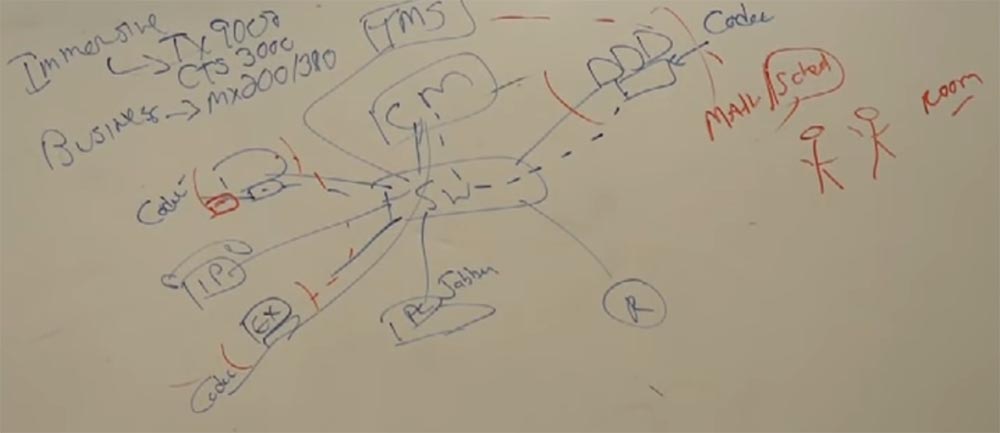
If someone tries to occupy this room and send an application for holding a conference there, TMS will inform you that at this time it is busy and it is impossible to hold a meeting there. He is responsible for the use of all rooms for video conferencing. Scheduling of conferences is possible through Google services for video presentations, for example, Coogle Talk. TMS is a server application, a virtual server. It is sold as any software product.
So, we had the first meeting and now we want to start the conference, now with the participation of three people and two rooms. I send members an invitation and send a request for rooms to TMS. But there is one problem. If 2 people are involved in a conversation, data transfer is simply organized between them. But if 3 people are involved, you need to create a video bridge. We connect the two infrastructures with a device called the MCU - a multipoint conference module. This module is designed to create video bridges.

It is based on equipment for displaying and broadcasting video streaming and is controlled by TMS. An MCU is hardware, or hardware, which can play the role of a software server. This is an expensive equipment, one MCU module costs 60-80 thousand dollars. Thus, if we need to combine several video broadcast points into a common network, we need an MCU. This is the dispatcher who changes the direction of the video to suit our needs.
In addition, the MCU ensures video compatibility at the meeting. Suppose a few people use screens with high resolution HD 1080, and someone uses a standard screen resolution. The MCU provides video transcoding. It receives signals from two screens with HD mode and translates them into a signal suitable for reproduction on the standard screen of a third conference participant. Conversely, a standard video signal is converted for display on a high resolution screen.
This device supports simultaneous operation of up to 188 HD screens in a single video conference. You can order the required number of MCU modules when you purchase the entire TMS complex, depending on how extensive the video conferencing is planned to be.
It is possible that with a large number of MCUs, we will need to call on an administrative assistant to help TMS. This software application, called Conductor, or “Conductor,” manages the MCU infrastructure.
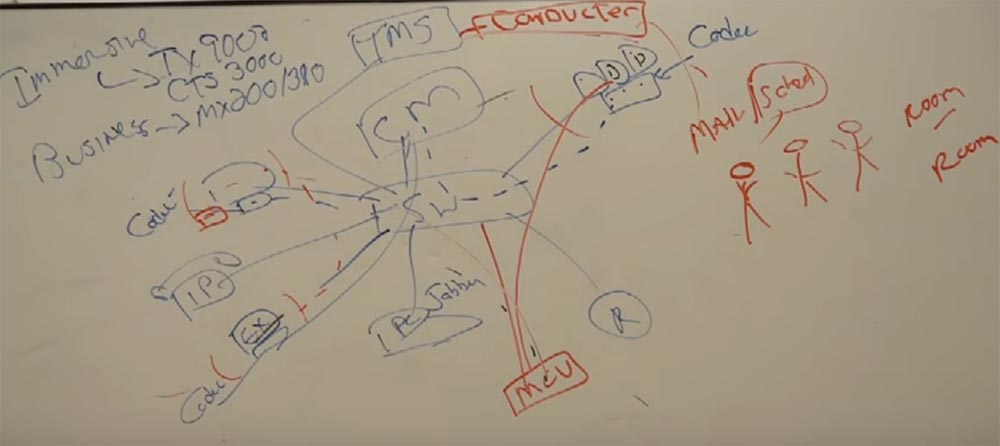
An important feature of this equipment is the protection of video conferencing from unauthorized access, that is, video encryption. It depends on the company's policy: for example, I will not be able to organize a videoconference between the financial director and the general director if it is not encrypted. In this case, streaming video is encrypted throughout the entire image transmission channel.
MCU can be placed anywhere, on the floor or on the ceiling. The video processing technology of the communication manager is the same as the voice processing technology. All our video devices are network devices that are managed by the communication manager and the TMS according to the schedule.
All this infrastructure is located behind a firewall that protects clients. I will draw an element of the hierarchical cellular structure of HCS outside our network and connect a router to it.
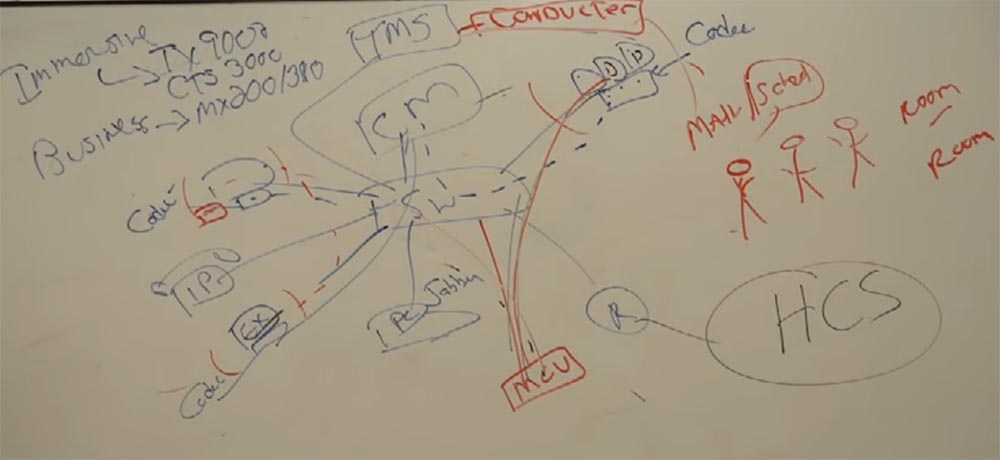
So, there is no difference between managing products that are hosted within our network and managing external products.
The HCS structure is proof that the Cisco architecture is working. We have non-traditional partners who want to provide voice services to clients. They have never worked with our architecture, but they are willing to invest in our server platform UCS and virtual servers that they upload their applications to. I mean companies that normally only worked with data transfer, like AT & T and Verizon. This is our modern policy of cooperation - we open the doors for them to new technologies.
Due to this we increase our sales. For example, if within three years the growth was 100%, 50%, 30%, this is very good. I will show two contact center Contact Center from the HCS structure and our network.

Why are contact centers important to customers? Because they receive technical support here, and for us attracting new customers is directly related to our income.
We have 2 types of contact centers: the CCX Express Contact Center is an application server and can handle 450 agents, and the CCE organizational contact center can scale the contact center to 7,000 agents. CCE combines several servers.
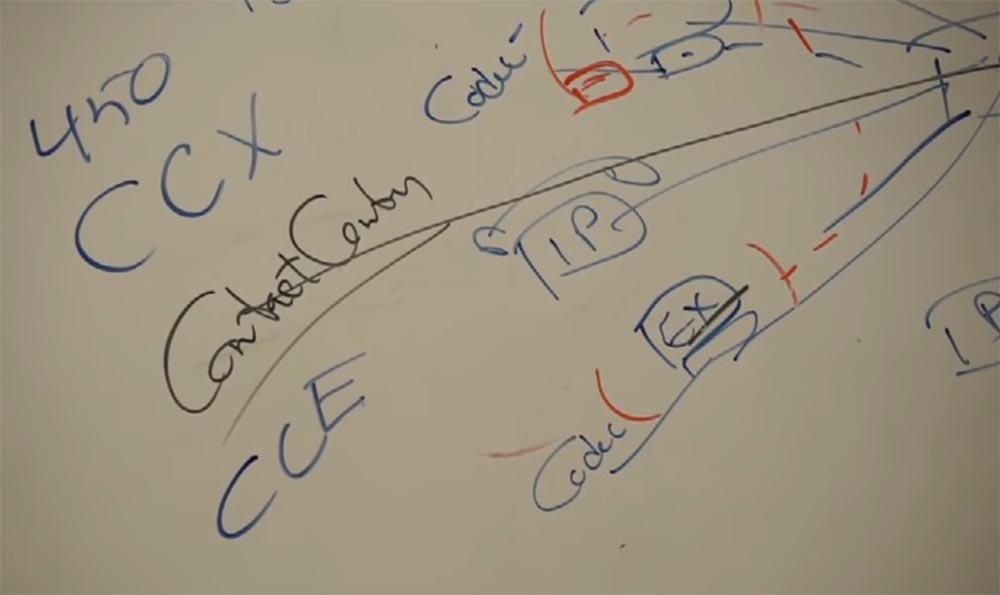
You will never hear about contact centers from IT specialists. To find out about SS, you need to contact the company's business unit. Avaya has always been a world leader in contact centers, and now, after the merger with Nortel, they have strengthened their positions.
Do you know what interesting things have happened to Avaya customers over the past years? This company went to the development of communications services in its own way and created large PBXs. Nortel had its own PBX version called Symposium. However, there was a big difference between them, like between Ford and Chevrolet - you cannot love both makes of cars at the same time, but give preference to one.
And all these people who have become accustomed to traditional telephony have received bad news - old technologies are leaving the market and will not be supported anymore. This gave us a great opportunity to intervene in the process with their decisions. Users got the choice to stay on with Nortel or select Cisco.
What was the new driver in the development of contact centers? Video! Customers wanted to be able to videoconferencing for 10 or 20% of their staff, and we began to provide this opportunity for at least 15% of the company's employees, that is, for managers.
Avaya, in partnership with Microsoft, created Rad Vision, but they didn’t have any network resources to develop their technology.
I note once again that you need to conduct a constructive conversation with customers to clarify their specific needs and the specifics of business processes. If we recall levels 8, 9 or 10, then cooperation with clients is the highest, 10th level, our religion. Clients do not want changes, they hate them, but the problem is that the industry itself is changing, it must change. So, we have to explain these changes to them, talk about the risks that they bear, we must be frank with them in order to reserve the first place in this area.
Another reason why customers like contact centers is the ability to upgrade them. And it is simply impossible to upgrade the traditional telephone network, it can only be completely replaced.
If there is a contact center outside our network that we can use as a host, this will be an example of partnership with the owners of this CC.
There are peak periods when providers need to expand network capabilities. For example, the annual mass filing of tax returns until April 15. In order for the network to withstand the peak load, customers can take advantage of our virtual hosting solution and a scalable virtual server anywhere.
Back in 2001, I’ll say that at that time Cisco was an anvil, such a huge, heavy piece of metal on which horseshoes are made. All that Cisco has complicated in due time, we now have to simplify. Figuratively speaking, then Cisco cut down a lot of trees, I mean electronic trees, and where one solution required one tree, Cisco took six. But over time, we have simplified this. We need to explain to clients how they should want to communicate, how to turn the past into the future and who will help them in this best of all.
Cisco has a long and successful history because we were the vanguard of advanced telephony technology. IP- , , .
, , .
Thank you for staying with us. Do you like our articles? Want to see more interesting materials? Support us by placing an order or recommending to friends, 30% discount for Habr users on a unique analogue of the entry-level servers that we invented for you: The Truth About VPS (KVM) E5-2650 v4 (6 Cores) 10GB DDR4 240GB SSD 1Gbps $ 20 or how to share the server? (Options are available with RAID1 and RAID10, up to 24 cores and up to 40GB DDR4).
Dell R730xd 2 times cheaper? Only we have 2 x Intel Dodeca-Core Xeon E5-2650v4 128GB DDR4 6x480GB SSD 1Gbps 100 TV from $ 249 in the Netherlands and the USA! Read about How to build an infrastructure building. class c using servers Dell R730xd E5-2650 v4 worth 9000 euros for a penny?

We continue the cycle of 27 articles based on his lectures:
')
01/02: “Understanding the OSI Model” Part 1 / Part 2
03: "Understanding the Cisco Architecture"
04/05: “The Basics of Switching or Switches” Part 1 / Part 2
06: "Switches from Cisco"
07: "Area of use of network switches, the value of Cisco switches"
08/09: "Basics of a Wireless LAN" Part 1 / Part 2
10: "Products in the field of wireless LAN"
11: The Value of Cisco Wireless LANs
12: Routing Basics
13: "The structure of routers, routing platforms from Cisco"
14: The Value of Cisco Routers
15/16: “The Basics of Data Centers” Part 1 / Part 2
17: "Equipment for data centers"
18: "The Value of Cisco in Data Centers"
19/20/21: "The Basics of Telephony" Part 1 / Part 2 / Part 3
22: "Cisco Collaboration Software"
23: The Value of Collaboration Products from Cisco
24: "The Basics of Security"
25: "Cisco Security Software"
26: "The Value of Cisco Security Products"
27: "Understanding Cisco Architectural Games (Review)"
And here is the twenty-first of them.
FastTrack Training. "Network Basics". "The Basics of Telephony." Part 3. Eddie Martin. December 2012
The communications manager of the SM is central to everything we do. And plays an important role for voice.
What is Jabber? I was waiting for this question from you! I wait for him every time I start talking about telephony. Jabber was originally the name of a company that created its own, non-standard protocol that was simpler than the traditional protocol used in SIP. The traditional protocol was not effective enough in this case.
Jabber created a separate protocol that was a more adaptable and thinner client that was easily used in networks. Cisco acquired Jabber in 2008. Their Jabber protocol has become the standard XMPP protocol that provided instant messaging and reported the user's presence on the network, and it is still used as the main protocol for this purpose.
Jabber is now a serious software client that Cisco uses on your devices. If you have a computer phone program, it uses Jabber for Windows, if you have a MacBook, it uses Jabber for Mac OS, if you have an iPhone, then it uses Jabber for iPhone. Jabber for iPad and Jabber for Android are available. It is a universal client for all mobile and stationary devices with any operating system. In fact, “Jabber” is a whole line of products that allows the exchange of voice messages. I use it on my MacBook and I can receive a voice mail message, and with the help of another client I can receive a video to it, even after a month. I think that the next version of Jabber will acquire this feature and will also be able to work with email video messages.
We need to download Jabber, if it is required by the CM communications manager, otherwise we do not need it.
Jabber also works with video, but in real time, like Skype, when I, for example, talk to my wife via MacBook. We can say that this is an analogue of Cisco's Cisco. Often, people incorrectly call Skype client, it is wrong. You cannot take Skype and put it inside our telephone network. Does a client need to know your IP address? Not. Simply log in to the server.

Suppose I take my iPhone, it is located on the right on our picture, I log in to the system and dial a person with an IP phone on the left side of the picture. My client interacts with the CM, his client also interacts with the CM, and the communications manager connects us. If I want to talk to another subscriber located outside our corporate network, the SM determines this, creates a secure “tunnel”, that is, a secure channel, and I call this subscriber as if he belonged to our network.

So, Jabber is our client. I note that there are no perfect clients for either Mac or Android.
What is WebEx? Where is he in this picture? He is in the cloud! He needs a cloud service company. This is a serious product, thanks to which we can create conferences and share our desktop, it also reports the presence of the user. It provides video broadcast solutions and allows you to record this event. In fact, we have as far as WebEx centers. This is the Meeting Center conference center that allows you to organize video bridges. We can share documents. This is followed by the Training Center. What is the difference between these centers?

In the training center, I can do whatever I want to organize a conference. Here I can create small groups of people, test their work, I can quickly select people into small groups and then quickly return them to the general group, I can instantly run conferences. This is really a very powerful tool.

Next we have a support center support center. Here we provide technical assistance, monitor your laptop and provide remote assistance to your desktop, if you need it.
Even in our WebEx there is an Event Center event center. Suppose I have a new product that I want to introduce everywhere, and I wish that 5,000 people would become familiar with it. I want them to purchase my equipment. Do I need to fly to all these people and offer it to them personally? No, I just join the center of events and create my own market there. I see my buyers there and I can even check whether they are satisfied with the purchase of the reviews they leave. This is a great deal for organizing trade.
The training center also helps to collect useful statistics, such as how many emails you send.
Jabber is a federated client, it is designed for federated networks where everyone can log in and create their own node. Users of this client can exchange messages using different servers.
The WebEx cloud service is free to interact with the Salesforce cloud service. We also provide our clients with a set of Jabber SDK development tools so that they can integrate the client into their SAP business automation systems.
The proposed architecture has unlimited possibilities. We can add more and more applications to it. We have a virtual server application that is compatible with any other applications.
I will note that the Jabber user can be placed outside of our federated network and our firewall, and it will still work with our corporate client. I can use this client on different servers.

We will now return to our old scheme. I will draw a communications manager SM, a switch, a router, a PC with Jabber, an IP phone.
Once Cisco acquired the Norwegian company Tandberg, which developed and manufactured equipment for video communications. Cisco has long been engaged in the development of video transmission tools. If you remember, in the late 1990s, Cisco created the Avid architecture for voice, video, and integrated data. I have seen a lot of sold systems for voice, but I have not seen sold systems for video transmission. This video equipment scares me a little, I am a specialist in networks that mainly use voice. Tandberg has made great strides in selling video systems. This has become very important and today everyone needs systems for video transmission.
Consider again how this was integrated into our solutions. CM establishes a connection and monitors calls. But suppose that you have the largest video device for conferences on three screens - the TX 9000 or CTS 3000. This is an Immersive device that creates a 3D volume image to cover the user. I will depict it in the left upper part of the picture, and to the right and above the switch I will place the video input device, without which our three screens are useless. This is a codec and image decoder. It is connected via a switch to the CM communication manager.

We know that CM manages the voice stream. But he also manages the video stream. I’ll add business video system MX 200/300 to the left. It has one screen. To process such an image, you need your video codec, I will draw it on the upper left of the switch. He is also associated with SM.
Let's add another personal video device of the EX 60/90 series with a screen of 21 or 24 inches. What is located outside of it? A codec that is also associated with a communications manager.
Thus, we can connect all these video devices to the SM just as we connected voice devices. However, the process of transmitting video is somewhat different from the process of voice transmission. How do we arrange a video conference? We can report it to participants via Outlook. Suppose I want to arrange a meeting with you three, but first I want to discuss important things with one of you.

I create an agenda, or a visit schedule. Suppose I want to talk to the first person in a room with three screens. I create a meeting, the participants of which will be me, he and the room with the screens.

I have a schedule like the one who made the appointment, you have it as an invitee, and what is the schedule for the room with screens? Tandberg's app called TMS is a presentation management suite. It controls the room, or rather, the video device placed in it. This application is a schedule or a schedule of equipment operation.
When I send a letter, it goes to the email inbox, and TMS replies that it received the letter and made a schedule for all your video equipment and a schedule for the rooms where it is located. In the room with our three screens there is a tablet, and if you go there at the appointed time, you can see the inscription on its screen: "Your conference is here." She was placed there by the communications manager SM. You press a button on the tablet and thereby send a CM signal that the conference has begun.
After receiving the signal, the CM addresses the TMS with a request for what is needed for the meeting. TMS replies that it is necessary to connect a room with three screens and a room where there is an EX screen. This is how the necessary connection between the participants of the meeting is established.

If someone tries to occupy this room and send an application for holding a conference there, TMS will inform you that at this time it is busy and it is impossible to hold a meeting there. He is responsible for the use of all rooms for video conferencing. Scheduling of conferences is possible through Google services for video presentations, for example, Coogle Talk. TMS is a server application, a virtual server. It is sold as any software product.
So, we had the first meeting and now we want to start the conference, now with the participation of three people and two rooms. I send members an invitation and send a request for rooms to TMS. But there is one problem. If 2 people are involved in a conversation, data transfer is simply organized between them. But if 3 people are involved, you need to create a video bridge. We connect the two infrastructures with a device called the MCU - a multipoint conference module. This module is designed to create video bridges.

It is based on equipment for displaying and broadcasting video streaming and is controlled by TMS. An MCU is hardware, or hardware, which can play the role of a software server. This is an expensive equipment, one MCU module costs 60-80 thousand dollars. Thus, if we need to combine several video broadcast points into a common network, we need an MCU. This is the dispatcher who changes the direction of the video to suit our needs.
In addition, the MCU ensures video compatibility at the meeting. Suppose a few people use screens with high resolution HD 1080, and someone uses a standard screen resolution. The MCU provides video transcoding. It receives signals from two screens with HD mode and translates them into a signal suitable for reproduction on the standard screen of a third conference participant. Conversely, a standard video signal is converted for display on a high resolution screen.
This device supports simultaneous operation of up to 188 HD screens in a single video conference. You can order the required number of MCU modules when you purchase the entire TMS complex, depending on how extensive the video conferencing is planned to be.
It is possible that with a large number of MCUs, we will need to call on an administrative assistant to help TMS. This software application, called Conductor, or “Conductor,” manages the MCU infrastructure.

An important feature of this equipment is the protection of video conferencing from unauthorized access, that is, video encryption. It depends on the company's policy: for example, I will not be able to organize a videoconference between the financial director and the general director if it is not encrypted. In this case, streaming video is encrypted throughout the entire image transmission channel.
MCU can be placed anywhere, on the floor or on the ceiling. The video processing technology of the communication manager is the same as the voice processing technology. All our video devices are network devices that are managed by the communication manager and the TMS according to the schedule.
All this infrastructure is located behind a firewall that protects clients. I will draw an element of the hierarchical cellular structure of HCS outside our network and connect a router to it.

So, there is no difference between managing products that are hosted within our network and managing external products.
The HCS structure is proof that the Cisco architecture is working. We have non-traditional partners who want to provide voice services to clients. They have never worked with our architecture, but they are willing to invest in our server platform UCS and virtual servers that they upload their applications to. I mean companies that normally only worked with data transfer, like AT & T and Verizon. This is our modern policy of cooperation - we open the doors for them to new technologies.
Due to this we increase our sales. For example, if within three years the growth was 100%, 50%, 30%, this is very good. I will show two contact center Contact Center from the HCS structure and our network.

Why are contact centers important to customers? Because they receive technical support here, and for us attracting new customers is directly related to our income.
We have 2 types of contact centers: the CCX Express Contact Center is an application server and can handle 450 agents, and the CCE organizational contact center can scale the contact center to 7,000 agents. CCE combines several servers.

You will never hear about contact centers from IT specialists. To find out about SS, you need to contact the company's business unit. Avaya has always been a world leader in contact centers, and now, after the merger with Nortel, they have strengthened their positions.
Do you know what interesting things have happened to Avaya customers over the past years? This company went to the development of communications services in its own way and created large PBXs. Nortel had its own PBX version called Symposium. However, there was a big difference between them, like between Ford and Chevrolet - you cannot love both makes of cars at the same time, but give preference to one.
And all these people who have become accustomed to traditional telephony have received bad news - old technologies are leaving the market and will not be supported anymore. This gave us a great opportunity to intervene in the process with their decisions. Users got the choice to stay on with Nortel or select Cisco.
What was the new driver in the development of contact centers? Video! Customers wanted to be able to videoconferencing for 10 or 20% of their staff, and we began to provide this opportunity for at least 15% of the company's employees, that is, for managers.
Avaya, in partnership with Microsoft, created Rad Vision, but they didn’t have any network resources to develop their technology.
I note once again that you need to conduct a constructive conversation with customers to clarify their specific needs and the specifics of business processes. If we recall levels 8, 9 or 10, then cooperation with clients is the highest, 10th level, our religion. Clients do not want changes, they hate them, but the problem is that the industry itself is changing, it must change. So, we have to explain these changes to them, talk about the risks that they bear, we must be frank with them in order to reserve the first place in this area.
Another reason why customers like contact centers is the ability to upgrade them. And it is simply impossible to upgrade the traditional telephone network, it can only be completely replaced.
If there is a contact center outside our network that we can use as a host, this will be an example of partnership with the owners of this CC.
There are peak periods when providers need to expand network capabilities. For example, the annual mass filing of tax returns until April 15. In order for the network to withstand the peak load, customers can take advantage of our virtual hosting solution and a scalable virtual server anywhere.
Back in 2001, I’ll say that at that time Cisco was an anvil, such a huge, heavy piece of metal on which horseshoes are made. All that Cisco has complicated in due time, we now have to simplify. Figuratively speaking, then Cisco cut down a lot of trees, I mean electronic trees, and where one solution required one tree, Cisco took six. But over time, we have simplified this. We need to explain to clients how they should want to communicate, how to turn the past into the future and who will help them in this best of all.
Cisco has a long and successful history because we were the vanguard of advanced telephony technology. IP- , , .
, , .
Thank you for staying with us. Do you like our articles? Want to see more interesting materials? Support us by placing an order or recommending to friends, 30% discount for Habr users on a unique analogue of the entry-level servers that we invented for you: The Truth About VPS (KVM) E5-2650 v4 (6 Cores) 10GB DDR4 240GB SSD 1Gbps $ 20 or how to share the server? (Options are available with RAID1 and RAID10, up to 24 cores and up to 40GB DDR4).
Dell R730xd 2 times cheaper? Only we have 2 x Intel Dodeca-Core Xeon E5-2650v4 128GB DDR4 6x480GB SSD 1Gbps 100 TV from $ 249 in the Netherlands and the USA! Read about How to build an infrastructure building. class c using servers Dell R730xd E5-2650 v4 worth 9000 euros for a penny?
Source: https://habr.com/ru/post/351388/
All Articles